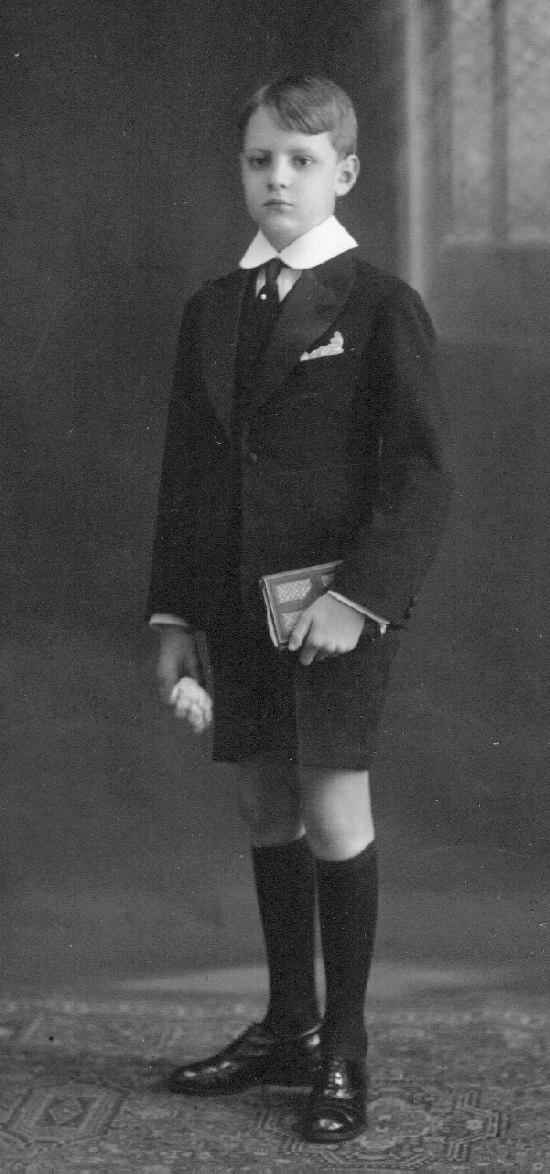
Belgian First Communion Suits: Chronology--1930s Suits

Figure 1.--This Belgian boy was photographed in 1938. He wears a rather formal black suit ith a button-on collar. Also note that he does not wear a sleeve bow as was common in France. This boy wore white gloves with his black suit. Click on the image for more details.
|
Boys in the 1930s were less commonly wearing sailor suits for First Communion. Most boys wore suits with the pants matching the coat jacket. Boys wearing shortpants would also commonly have matching kneesocks. Although boys wearing gloves would normally wear white gloves rather than gloves matching the suit. I do not know if caps were commonly worn with the suits. Both single and double breasted suits were worn. Wide lapels were considered rather stylish. Other are suits with destinct patterns such as stripes. They look rather like the boys' regular suit rather one purchased specifically for First Communion. We do not note, for example, white suits. The number of images we have is still limited, so we cannot yet say definatively that no boys wore white suits.
Sailor Suits
Boys in the 1930s were less commonly wearing sailor suits for First Communion. We believe that some Belgian boys did wear sailor suits, but not nearly as commonly as before.
Suits
Most boys wore suits with the pants matching the coat jacket. Boys wearing shortpants would also commonly have matching kneesocks. Although boys wearing gloves would normally wear white gloves rather than gloves matching the suit. I do not know if caps were commonly worn with the suits. Both single and double breasted suits were worn. Some are very formal looking black suits. We believe that black was considered more formal than lighter-colored suits with patterns. Some are regularly cut jackets, others look a bit like tuxedos. Wide lapels were considered rather stylish. Other are suits with destinct patterns such as stripes. They look rather like the boys' regular suit rather one purchased specifically for First Communion. We do not note, for example, white suits. The number of images we have is still limited, so we cannot yet say definatively that no boys wore white suits.
Formal suits
Some boys wore formal suits. The black suit seen here is a ood example (figure 1). These are suits that werre suitable only for First Communion or a few formal events like weddings. A a result, these formal suits were probably mst common for boys from affluent families. Some boys may have also worn them to church. Some are very formal looking black suits. We believe that black was considered more formal than lighter-colored suits with patterns. Some of the formal suits look rather like tuxedos. We do not note, for example, white suits. The number of images we have is still limited, so we cannot yet say definatively that no boys wore white suits. Black appears to have been much more accepted as the appropriate color for these formal suits. Some had vests. Detachable stiff collars were still worn for these formal suits, but by the 1930s soft collars were also worn. They would always be worn with matching black hosiery. Some boys may have worn long stockings, but by the 1930s, black kneesocks appear more common. Contrasting with the black suits were the white shrts and white goves. Almost all boys wearing formal First Communion suits had white gloves. I am not sure about caps.
Informal suits were more common or First Communion than the formal suits. This was because that an informal suit could be used for many other purposes after the ceremony. Class factors could be involved here. Many families would have been streached to afford a formal suit just for First Communion. These informal suits had regularly cut jackets. There were both single and double-breasted suits, but the single-breasted suits were more common for these informal suits. Wide lapels were considered rather stylish. Many of theses suits had destinct patterns such as stripes rather than being solid colors. Solid colored suits, however, were also worn. They look rather like the boys' regular suit rather one purchased specifically for First Communion. Boys wore white shirts, almost always wth soft collars. Most boys wore short pants suits. We have noted a few boys which still had the the three button trim that had been worn on kneepants. They were commonly worn with patterened kneesocks. Many boys did not wear gloves, but some tht did wore dark colored gloves and notalways hite gloves as worn with he formal suits. I am not sure about caps.
Christopher Wagner

Navigate the Boys' Historical Clothing Web Site religious pages:
[Return to the Main Belgian First Communion 1930s chronology page]
[Return to the Main Belgian activities page]
[Return to the Main communion page]
[First Communion]
[Confirmation]
[Ring bearer]
[Victorian wedding]
Navigate the Historic Boys' Clothing Web Site:
[Introduction]
[Activities]
[Biographies]
[Chronologies]
[Countries]
[Style Index]
[Bibliographies]
[Contributions]
[FAQs]
[French glossary]
[Dutch glossary]
[Satellite site]
[Tools]
[Boys' Clothing Home]
Navigate the Historic Boys' Clothing Web chronological pages:
[The 1900s]
[The 1910s]
[The 1920s]
[The 1930s]
[The 1940s]
[The 1950s]
[The 1960s]
[The 1970s]
Navigate the Historic Boys' Clothing Web style pages:
[Short pants suits]
[Blazers]
[Jackets]
[Kilts]
[Sailor suits]
[Sailor hats]
[Ring bearer/page costumes]
[Shortalls]
Created: June 17, 2002
Last edited: June 17, 2002



